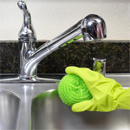 Every year millions of people get sick from eating food, including dishes prepared in their own kitchens. Some germs are simply a nuisance while others can be dangerous. Getting to know the top threats in your kitchen can help you put a preventative plan in place to avoid illness.
Every year millions of people get sick from eating food, including dishes prepared in their own kitchens. Some germs are simply a nuisance while others can be dangerous. Getting to know the top threats in your kitchen can help you put a preventative plan in place to avoid illness.
Tops threats
• Your hands: we have all heard how washing hands is a good preventative measure when it comes to cold and flu. Health officials across the country say the same applies if you want to avoid contaminating your food. Although it makes common sense, nurses who still visit schools say they see children and teachers picking up their food with dirty hands all the time, putting their immune system to the test.
• Sponge or cloth: germs such as salmonella and e-coli collect on your kitchen sponge or cleaning cloth. Studies have shown that over 100 different types of germs, including those associated with mold and yeast can be found on kitchen sponges so replace them at least every 2 weeks and clean them regularly. One way to sterilize them is to microwave them for 2 minutes.
• Cooking temperature: the more you cook something the less likely it is to have bacteria in it and thus the less likely you are to compromise your immune system.
• Cutting boards: cooked food, fresh fruit, and vegetables can get contaminated if you place them on a cutting board that was used for uncooked meats and fish. A good preventative measure would be to use separate cutting boards for meat/fish/produce/ and cooked foods.
• Drains: Bacteria like moist areas to hide away in so drains are full of bacteria. They can be cleaned out with some baking soda and a little scrubbing with an old toothbrush.
• Fridge temperature: to avoid cold and flu like symptoms or worse ailments, make sure your refrigerator doesn’t dip below 40 degrees F. The colder temperature slows the growth of bacteria.
There are other threats that you bring into the kitchen. For example, many consumers like to shop with reusable grocery bags; however, tests have shown that bacteria can build up in the cloth or plastic and contaminate your next purchase so make sure you wash those bags after each trip to the market. Another preventative tactic is to keep raw meat, fish, and poultry away from the ready to eat food in your grocery cart.
According to studies on food borne illness, the majority of kitchen germs cause a cold and flu like reaction. Often time’s people don’t even know they have a food borne sickness, they think they have the actual cold and flu. Doctors say sometimes germs weaken the immune system so that the body can’t fight off any annoying viruses that are going around.
Preventative steps such as the ones outlined above can go a long way in keeping your kitchen clean and safe, especially for people who are in a high risk category. High risk includes people who have serious illness or chronic diseases. They have difficulty fighting off food borne illness due to a weakened immune system.
When it comes to buying groceries, storing food, and cleaning your kitchen there are several preventative measures you can take to maintain safety. Government websites like Health Canada provide detailed information on food storage, cooking, and defrosting. Preventative health messages are also posted at www.befoodsafe.ca, including information about food recalls in Canada.
Food experts agree that a little care in the kitchen can keep you germ free and that means the cold and flu, as well as serious illness can be held at bay.
Advertisement
